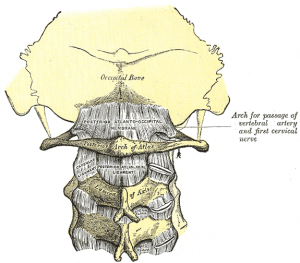Episode28 Kinesiology of cervical spine4 The atlanto Biology Diagrams These ligamentous structures facilitate approximately 50% of cervical flexion-extension at the atlanto-occipital joint. The atlantoaxial complex enables roughly 50% of total cervical rotation through controlled movement between C1 and C2. Stability Mechanisms. The ligamentous system provides both passive and dynamic stability. The articulating surfaces of the joint are the occipital condyles of the cranium and the superior articular surfaces of the lateral masses of the atlas (C1). There is variety in the shape of the occipital condyles, including oval in 50%, S-shaped in 23.2% and triangular in 9% (Naderi et al, 2005). The atlanto-occipital joint may be dislocated, especially from violent accidents such as traffic collisions. [1] This may be diagnosed using CT scans or magnetic resonance imaging of the head and neck. [1] Surgery may be used to fix the joint and any associated bone fractures. [1] Neck movement may be reduced long after this injury. [1] Such injuries may also lead to hypermobility, which may

Atlanto-occipital joint: Anatomy & Function Anatomy, function, innervation, and blood supply of the atlanto-occipital joint ~ 2-3 min. The vertebral column is connected to the skull with three joints: the atlanto-occipital, the median atlanto-axial and the lateral atlanto-axial joint. The atlanto-occipital joint is the articulation between the atlas (C1 vertebra) and the occipital bone of the skull. It is a synovial joint that allows for. The atlantooccipital joint is the articulation between the atlas and the occipital bone. It consists of a pair of condyloid joints. The ligaments connecting the bones are: Two Articular Capsules The Anterior Atlantoöccipital membrane The Posterior Atlantoöccipital membrane Two Lateral Atlantoöccipital. There are two synovial membranes: one lining each of the articular capsules.

Complete Anatomy - Elsevier Biology Diagrams
The atlanto-occipital joint also known as the C0-C1 is a paired symmetrical articulation between the cervical spine and the base of the skull.It includes the occipital condyle and the superior articular surfaces of the first cervical vertebra (C1 or Atlas), allowing flexion, extension and lateral tilt of the head.Along with the atlantoaxial joint, it makes up a group called the craniovertebral
